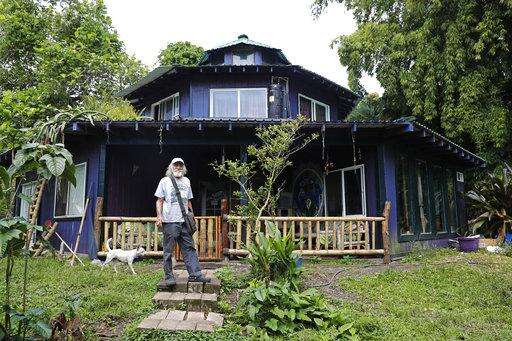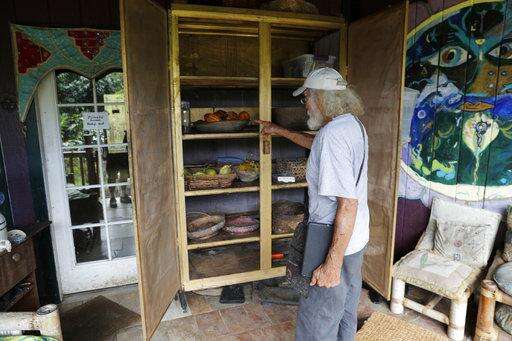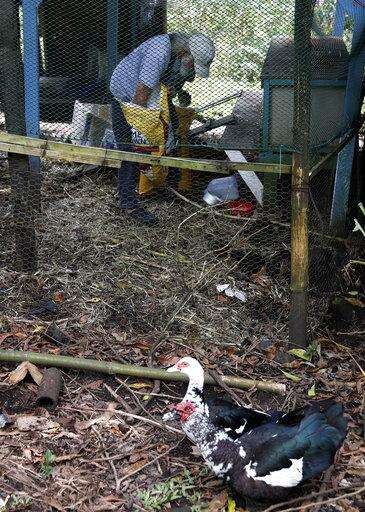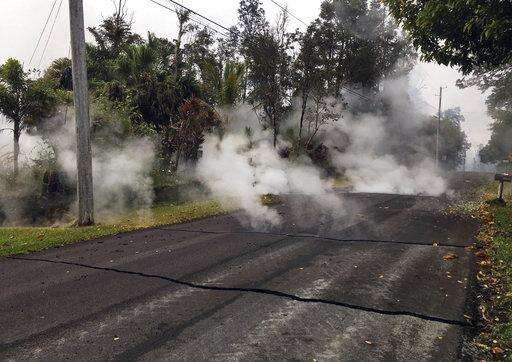First Lt. Aaron Hew Len, of the U.S. National Guard, tests air quality near cracks that are emitting toxic gasses from a lava flow in the Leilani Estates subdivision near Pahoa, Hawaii, Tuesday, May 8, 2018. Scientists confirm that volcanic activity has paused at all 12 fissures that opened up in a Hawaii community and oozed lava that burned 35 structures. Officials warn that hazardous fumes continue to be released from the cracks in the ground. (AP Photo/Caleb Jones)
The Associated Press
PAHOA, Hawaii (AP) - Edwin Montoya's family carved their farm on the slopes of the Kilauea volcano out of "raw jungle," transforming it into a fertile collection of gardens, animal pens and fruit trees.
Now the property is imperiled by the very land it stands upon. A couple of miles up the hill, lava has destroyed dozens of homes and his daughter's farm is in an evacuation zone.
Despite the nearby danger, Montoya plans to stay unless he is forced to leave. "I'm going to go ahead and stick it out," he said. "If it happens, if it blows its top and I'm there at the time, I'm 76 years old. I've lived a good life."
Because there's no indication when the eruption might stop, or how far the lava might spread, the volcano has forced people living in and around the Leilana Estates subdivision to make tough decisions.
Some residents insist on staying to watch over their property. Others have abandoned their homes without knowing when they will be able to return, or if they will come back to find their houses turned to ash and buried under solid rock.
Andrew Nisbet evacuated last week and has no idea what has happened since.
"My home is right in the line of the major breakouts so maybe, maybe not." he said Monday during a community meeting.
Authorities urged Scott Wiggers to evacuate, but he refused.
"I'm in the safest part in the subdivision. There's no threat to my house whatsoever," said Wiggers, a tour guide.
Wiggers said he wasn't leaving his home on the outskirts of the evacuation zone because he worried that if he did, he wouldn't be able to get back in. But he's prepared in case the situation takes a turn.
"I am packed. My truck is loaded. I'm not a dumb-dumb. If I see a threat, I'm out of here," he said.
Hawaii Gov. David Ige told evacuees he has called the White House and the Federal Emergency Management Agency to tell officials that he believes the state will need help to deal with the volcano on the Big Island.
Authorities are allowing some evacuees to return briefly each day to gather medicine, pets and other necessities.
Montoya, who moved to Hawaii to be with his family about six years ago, said he saw most of the United States as a truck driver for 25 years on the mainland. He prefers life on Mystic Forest Farm, in a purple octagonal house his family built nearly 20 years ago.
The farm is at the end of a long, single-lane gravel road, with large volcanic rocks scattered about and large pools of water to drive through.
Montoya is tending to the farm's animals - sheep, chickens, rabbits and several cats and dogs - and watching over the property to prevent looting.
Officials warn that lava could flow downhill and burn areas that are not currently in danger, and toxic volcanic gas could kill people, especially the elderly and those with breathing problems.
Events remain unpredictable. On Sunday, the first day residents were allowed back in, a cellphone alert went out urging people to leave after a vent opened and began spewing sulfur dioxide. Officials were worried that some residents could become trapped.
The fumes wafted down on the farm from the open fissures above.
"It was really cloudy with a lot of sulfur in the air," Montoya said. "It hurt my throat. It was pretty miserable."
Residents of Lanipuna Gardens, a subdivision directly to the east of Leilana Estates, still cannot return because of danger from volcanic gases.
Montoya's 45-year-old daughter, Tesha "Mirah" Montoya, wasn't especially worried about the gases. The tipping point for her to evacuate, she said, was the earthquakes that preceded the eruption.
"I felt like the whole side of our hill was going to explode," she said after a magnitude 6.9 quake rocked her land. "My heart and soul's there," she said in a phone interview from a cabin on the north side of the Big Island, where the family had hunkered down. "I'm nothing without the land. It's part of my being."
The family's property on Kilauea (pronounced kill-ah-WAY'-ah) has several buildings and cabins, gardens and animal coops. The land also has about 130 kinds of exotic fruit trees. There's a pineapple patch and enough food stored away to last a long time, she said.
There are 12 lava-producing fissures in Leilani Estates, but the flow of lava is not constant. No lava was flowing as of late Monday, said Janet Snyder, a spokeswoman for Hawaii County.
A total of 35 structures, including 26 confirmed homes, have been destroyed. Aerial surveys cannot make out whether some of the structures are homes or other types of buildings.
Edwin Montoya is happy staying on the farm, tending to animals and eating from the trees. He's living the life he wants, just like many in this rural landscape in the shadow of one of the world's most active volcanoes.
"It's where I want to rest my bones," Edwin Montoya said. "But nevertheless, I will survive. I'm sure I will survive."
___
Associated Press video journalist Haven Daley in Pahoa and writer Alina Hartounian in Phoenix contributed to this report.
In this Saturday, May 5, 2018, photo, Edwin Montoya, 76, walks on his family's property near Pahoa, Hawaii. Just a couple of miles up the hill, lava has been gushing from the ground and destroying dozens of homes as new eruptions and earthquakes have rattled the region. His property is within the mandatory evacuation zone, but Montoya, who was finally able to get back to the farm on Saturday afternoon, plans to stay there unless he is forced to leave. (AP Photo/Marco Garcia)
The Associated Press

In this Saturday, May 5, 2018, photo, Edwin Montoya, 76, poses for a photo outside his home near Pahoa, Hawaii. Just a couple of miles up the hill, lava has been gushing from the ground and destroying dozens of homes as new eruptions and earthquakes have rattled the region. His property is within the mandatory evacuation zone, but Montoya, who was finally able to get back to the farm on Saturday afternoon, plans to stay there unless he is forced to leave. (AP Photo/Marco Garcia)
The Associated Press

In this Saturday, May 5, 2018, photo, Edwin Montoya, 76, carries a bucket on his family's property near Pahoa, Hawaii. Just a couple of miles up the hill, lava has been gushing from the ground and destroying dozens of homes as new eruptions and earthquakes have rattled the region. His property is within the mandatory evacuation zone, but Montoya, who was finally able to get back to the farm on Saturday afternoon, plans to stay there unless he is forced to leave. (AP Photo/Marco Garcia)
The Associated Press

In this Saturday, May 5, 2018, photo, Edwin Montoya, 76, looks at fruit in the pantry on his family's property near Pahoa, Hawaii. Just a couple of miles up the hill, lava has been gushing from the ground and destroying dozens of homes as new eruptions and earthquakes have rattled the region. His property is within the mandatory evacuation zone, but Montoya, who was finally able to get back to the farm on Saturday afternoon, plans to stay there unless he is forced to leave. (AP Photo/Marco Garcia)
The Associated Press

In this Saturday, May 5, 2018, photo, Edwin Montoya, 76, feeds chickens on his family's property near Pahoa, Hawaii. Just a couple of miles up the hill, lava has been gushing from the ground and destroying dozens of homes as new eruptions and earthquakes have rattled the region. His property is within the mandatory evacuation zone, but Montoya, who was finally able to get back to the farm on Saturday afternoon, plans to stay there unless he is forced to leave. (AP Photo/Marco Garcia)
The Associated Press

In this Saturday, May 5, 2018, photo, Edwin Montoya, 76, feeds his dogs at a campsite near his home near Pahoa, Hawaii. Just a couple of miles up the hill, lava has been gushing from the ground and destroying dozens of homes as new eruptions and earthquakes have rattled the region. His property is within the mandatory evacuation zone, but Montoya, who was finally able to get back to the farm on Saturday afternoon, plans to stay there unless he is forced to leave. (AP Photo/Marco Garcia)
The Associated Press

This Monday, May 7, 2018 photo from the U.S. Geological Survey shows gas and steam rising from multiple fissures on Moku Street in the Leilani Estates Subdivision near Pahoa on the island of Hawaii. Kilauea volcano has destroyed more than two dozen homes since it began spewing lava hundreds of feet into the air last week, and residents who evacuated don't know how long they might be displaced. The decimated homes were in the Leilani Estates subdivision, where molten rock, toxic gas and steam have been bursting through openings in the ground created by the volcano. (U.S. Geological Survey via AP)
The Associated Press

First Lt. Aaron Hew Len, of the U.S. National Guard, tests air quality near cracks that are emitting toxic gasses from a lava flow in the Leilani Estates subdivision near Pahoa, Hawaii, Tuesday, May 8, 2018. Scientists confirm that volcanic activity has paused at all 12 fissures that opened up in a Hawaii community and oozed lava that burned 35 structures. Officials warn that hazardous fumes continue to be released from the cracks in the ground. (AP Photo/Caleb Jones)
The Associated Press
First Lt. Aaron Hew Len, of the U.S. National Guard, tests air quality near cracks that are emitting toxic gasses from a lava flow in the Leilani Estates subdivision near Pahoa, Hawaii, Tuesday, May 8, 2018. Scientists confirm that volcanic activity has paused at all 12 fissures that opened up in a Hawaii community and oozed lava that burned 35 structures. Officials warn that hazardous fumes continue to be released from the cracks in the ground. (AP Photo/Caleb Jones)
The Associated Press
A cooled lava flow covers a road in the Leilani Estates subdivision near Pahoa, Hawaii, Tuesday, May 8, 2018. Scientists confirm that volcanic activity has paused at all 12 fissures that opened up in a Hawaii community and oozed lava that burned 35 structures. Officials warn that hazardous fumes continue to be released from the cracks in the ground. (AP Photo/Caleb Jones)
The Associated Press
First Lt. Aaron Hew Len, of the U.S. National Guard, tests air quality near cracks that are emitting toxic gasses from a lava flow in the Leilani Estates subdivision near Pahoa, Hawaii, Tuesday, May 8, 2018. Scientists confirm that volcanic activity has paused at all 12 fissures that opened up in a Hawaii community and oozed lava that burned 35 structures. Officials warn that hazardous fumes continue to be released from the cracks in the ground. (AP Photo/Caleb Jones)
The Associated Press
An item sits on a cooled lava flow in the Leilani Estates subdivision near Pahoa, Hawaii, Tuesday, May 8, 2018. Scientists confirm that volcanic activity has paused at all 12 fissures that opened up in a Hawaii community and oozed lava that burned 35 structures. Officials warn that hazardous fumes continue to be released from the cracks in the ground. (AP Photo/Caleb Jones)
The Associated Press
A lava flow sits on the lawn of a home in the Leilani Estates subdivision near Pahoa, Hawaii, Tuesday, May 8, 2018. Scientists confirm that volcanic activity has paused at all 12 fissures that opened up in a Hawaii community and oozed lava that burned 35 structures. Officials warn that hazardous fumes continue to be released from the cracks in the ground. (AP Photo/Caleb Jones)
The Associated Press
First Lt. Aaron Hew Len, of the U.S. National Guard, tests air quality near cracks that are emitting toxic gasses from a lava flow in the Leilani Estates subdivision near Pahoa, Hawaii, Tuesday, May 8, 2018. Scientists confirm that volcanic activity has paused at all 12 fissures that opened up in a Hawaii community and oozed lava that burned 35 structures. Officials warn that hazardous fumes continue to be released from the cracks in the ground. (AP Photo/Caleb Jones)
The Associated Press
First Lt. Aaron Hew Len, of the U.S. National Guard, tests air quality near a cooled lava flow in the Leilani Estates subdivision near Pahoa, Hawaii, Tuesday, May 8, 2018. Scientists confirm that volcanic activity has paused at all 12 fissures that opened up in a Hawaii community and oozed lava that burned 35 structures. Officials warn that hazardous fumes continue to be released from the cracks in the ground. (AP Photo/Caleb Jones)
The Associated Press
Raylene Lerum and Maj. Ryan Morrisey of the U.S. National Guard survey damage in the Leiliani Estates subdivision near Pahoa, Hawaii, on Tuesday, May 8, 2018. Lerum was one of about 1,700 residents ordered to evacuate after Kilauea volcano began erupting May 3, 2018. She has not yet been able to return to her home, and doesn't know if it was one of the 26 houses that have been destroyed. (AP Photo/Caleb Jones)
The Associated Press
First Lt. Aaron Hew Len with the US National Guard surveys lava damage in the Leilani Estates subdivision near Pahoa, Hawaii, on Tuesday, May 8, 2018. About 1,700 residents of the subdivision were ordered to evacuate after Kilauea began erupting May 3, 2018, destroying at least 26 homes. (AP Photo/Caleb Jones).
The Associated Press
A street destroyed by lava in the Leilani Estates subdivision near Pahoa, Hawaii, is shown Tuesday, May 8, 2018. About 1,700 residents of the subdivision were ordered to evacuate after Kilauea began erupting May 3, 2018, destroying at least 26 homes. (AP Photo/Caleb Jones).
The Associated Press
This May 6, 2018, false-color image taken from the Advanced Spaceborne Thermal Emission and Reflection Radiometer (ASTER) onboard NASA's Terra satellite shows new fissures with long yellow streaks being plumes of sulphur dioxide gas, during eruptions of the Kilauea volcano on the island of Hawaii. Red areas are vegetation, and black and gray areas are old lava flows. (NASA via AP)
The Associated Press